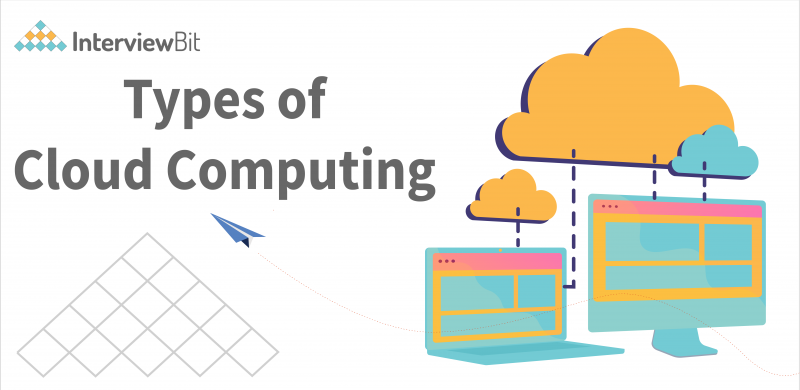- Introduction to Cloud Computing
- Characteristics of Cloud Computing:
- Types of Cloud
- FAQs
- Q.1: Which cloud type should be used where?
- Q.2: Which is the safest and most secure cloud type?
- Q.3: Which is the most cost-effective cloud?
- Q.4: Which cloud offers the best resources?
- Additional Resources
Introduction to Cloud Computing
Cloud computing refers to the use of shared computing resources. Applications, processing, storage, networking, development and deployment platforms, and business processes are all examples of these resources. Cloud computing simplifies the usage of computing resources by offering standardization and automation.
However, Cloud Computing does not mean that it comprises only one cloud. The phrase “cloud” refers to the Internet, which is a network of networks in itself. Furthermore, Cloud Computing does not include all forms of remote computing. There are various types of cloud computing that product-based companies and startups are using these days to increase the scalability and efficiency of their systems.
A cloud is a collection of services, networks, hardware, storage, and interfaces that enable computing as a service to be delivered. The end-user, business management user, and cloud service provider are the three types of users in general:
Confused about your next job?
- The end-user is the person who makes use of the cloud’s services.
- The business management user in the cloud takes responsibility for the data and services provided by the cloud.
- The cloud service provider is the one who looks after or is in charge of maintaining the cloud’s IT assets. The cloud serves as a central location for users to meet their computing requirements.
Characteristics of Cloud Computing:
Some of the key characteristics of cloud computing are as follows:
- Agility: Assists in resource re-provisioning in a timely and cost-effective manner.
- Location Independence: This refers to the resources ability to be accessible from any location.
- Multi-Tenancy: A large number of users share the same resources.
- Reliability: Accessibility is dependent on the availability of resources and computation.
- Scalability: Dynamic provisioning of data leads to highly scalable systems.
Read More About – Characteristics of Cloud Computing
Types of Cloud
Private clouds, public clouds, hybrid clouds, and multi-clouds are the four basic types of cloud in cloud computing that you can deploy according to the needs of the particular organization.
Models that depict computing environments are known as cloud delivery models. Infrastructure-as-a-Service (IaaS), Platforms-as-a-Service (PaaS), and Software-as-a-Service are the three primary categories of cloud computing services (SaaS).
- Infrastructure as a Service (IaaS) refers to the on-demand delivery of services such as an operating system, storage, networking, and numerous utility software components.
- Infrastructure as a Service (IaaS) is combined with an abstracted set of middleware services, software development, and deployment tools in Platform as a Service (PaaS). These enable the organization to design and deploy applications in a cloud or on-premises environment in a uniform manner.
- A business application built and hosted by a provider in a multi-tenant architecture is known as Software as a Service (SaaS).
- Customers can use Function as a Service (FaaS) to design, manage, and operate app functionality without having to worry about managing infrastructure. As a result, a “serverless” architecture can be achieved.
Selecting a cloud type or service is a necessary and elementary decision. No two clouds (even if they’re of the same type) are alike, and no two cloud services are utilized to solve the same problem. However, understanding the commonalities will help you better understand how the limitations of each cloud computing model and cloud service may affect your organization.
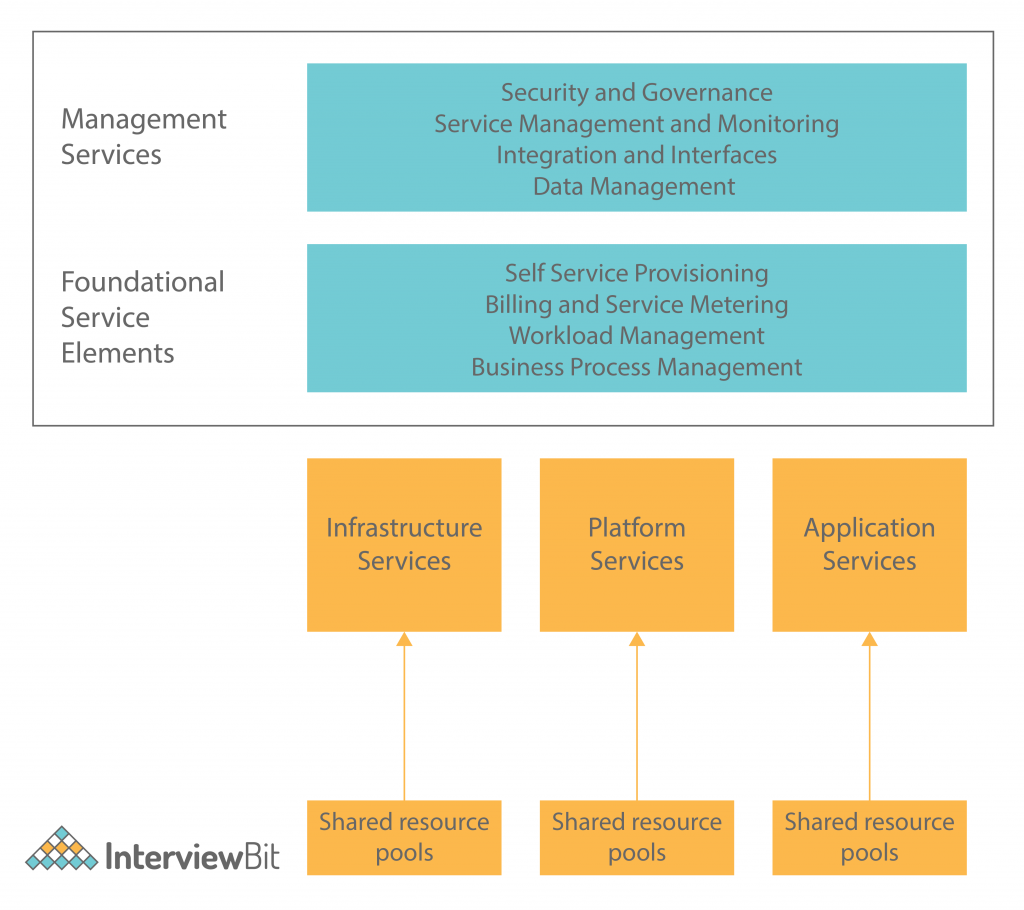
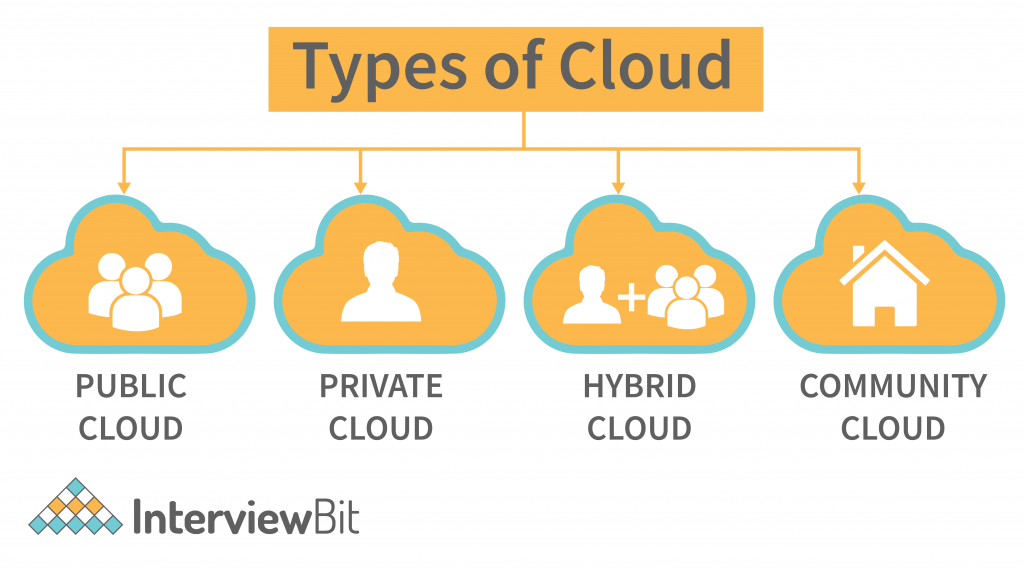
1. Public Cloud
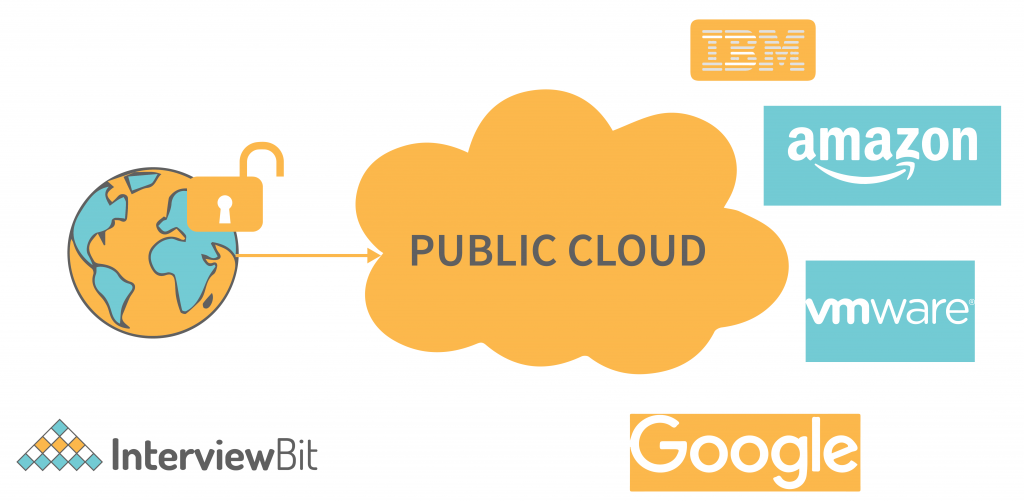
The public cloud is a pay-per-use service that allows anyone to store and retrieve information through the Internet. The Cloud Service Provider (CSP) manages and operates computer resources in the public cloud.
Multiple users are using the same storage in the public cloud at the same time.
Businesses, colleges, government entities, or a combination of them own, administer, and operate the public cloud.
Amazon Elastic Compute Cloud (EC2), IBM SmartCloud Enterprise, Microsoft, Google App Engine, and Windows Azure Services Platform are all examples of public cloud computing platforms.
Advantages of Public Cloud
- Low Cost: When compared to private and hybrid clouds, public clouds can be owned at a lower cost.
- Location Independent: Since the public cloud is accessible using the internet, it is independent of location.
- Time-Saving: Since Cloud Service Providers (CSP) are responsible for providing the public clouds, users can focus on other aspects such as establishing a cloud connection, deployment of products on cloud, releasing timely updates, and configuring various servers.
- Easy to set up: Within a few hours, organizations can buy a public cloud on the internet and have it deployed and configured remotely through the cloud service provider.
- Scalability and Reliability: Cloud Service Providers (CSP) provide you the ability to increase the computer resources (or remove connections), based on requirements and load on servers. These services are very reliable, i.e. 24 * 7 available at a minimal cost.
Disadvantages of Public Cloud
- Low Security: Since resources are shared publicly across the internet, public clouds are bound to be less secure when compared to private or hybrid clouds.
- Performance Dependency: The performance of public clouds entirely depends on the speed of the internet. Hence, areas with poor internet connectivity might face lower performance.
- Less Customizable: Public clouds are less customizable when compared with the customizability offered in private clouds.
2. Private Cloud
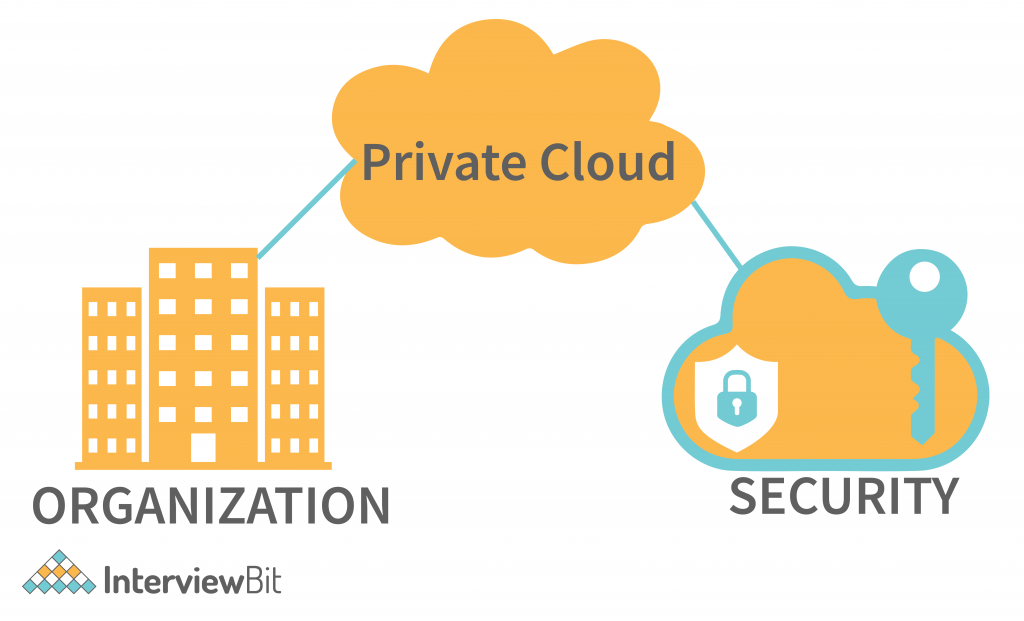
Instead of public availability, a private cloud provides software services to a private internal network, generally within an organization or to selected users.
Organizations use it to develop and run their own data centers in-house or through a third-party provider. Private clouds are also known as corporate clouds or internal clouds.
Through firewalls and internal hosting, the private cloud ensures that data is secure and private. It also assures that third-party providers do not have access to operational or sensitive data.
There are two ways to establish a private cloud. The typical approach is to have their infrastructure set up for Intranet or private networks. This technique is used by organizations like Infosys, Wipro, and other traditional service-based companies.
The second option is to use a VPC (Virtual Private Cloud) (VPC). They still have a private cloud in this situation, but it’s accessible via the public Internet with the help of cloud providers. In this situation, a corporation will use a private cloud to host its website, with no public IP assigned to any resource. Employees will connect to the site using a VPN.
Google is perhaps the only firm with a global private infrastructure, and none of their Google cloud infrastructures is accessible via the public Internet.
Advantages of Private Cloud
- More Control: Because the cloud is administered by the company, the company has complete control over it. As a result, the organization does not need to rely on anyone.
- Security And Privacy: There is a high level of security and privacy when using private clouds since it is limited to selected users within an organization.
- High Performance: Private clouds have high-performance metrics when compared to hybrid and public clouds. It has better speed and speed capacity.
Disadvantages of Private Cloud
- High Cost: Because setting up and maintaining hardware resources is costly, private clouds are overall more expensive than public clouds.
- Location Dependent: Because the private cloud is only available within the business, the operational area is constrained.
- Limited Scalability and Skilled Labour: Organizations with a large user base, as well as those without the pre-built infrastructure and the people to operate and manage the cloud, should not consider the private cloud.
3. Hybrid Cloud
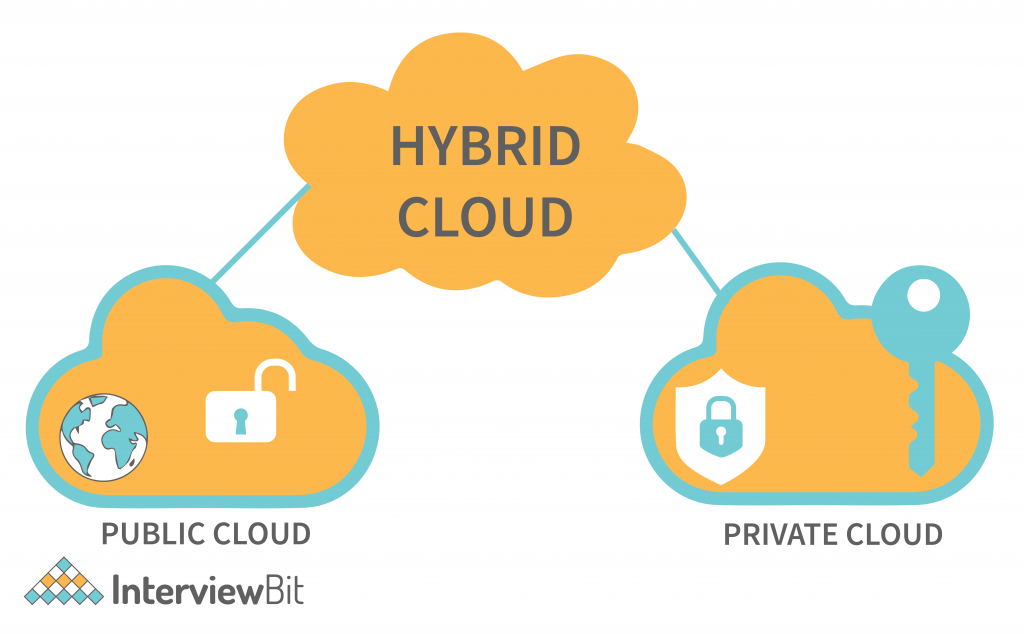
The term “hybrid cloud” refers to a system that is a combination of both public and private clouds, i.e. public cloud + private cloud = hybrid cloud. The primary goal of combining public and private clouds is to create an automated, unified and well-managed computing environment.
Non-critical operations are handled by the public cloud, while crucial operations are handled by the private cloud in the Hybrid cloud. Using hybrid clouds, you should be able to connect many computers and consolidate IT assets.
A hybrid cloud is mostly employed in finance, healthcare, and higher education.
Amazon, Microsoft, Google, Cisco, and NetApp are the leading hybrid cloud providers.
Advantages of Hybrid Cloud
- Low Cost: A hybrid cloud is less expensive than a private cloud. It aids enterprises in reducing infrastructure and application support costs.
- Adaptable or Flexible: Since hybrid clouds are composed of public clouds which provide flexible resources, they can adapt to the space, memory, and system requirements that each firm has.
- Safety and Security: Because critical operations are handled by the private cloud, the hybrid cloud is secure.
- Risk Assessment and Management: The hybrid cloud is an excellent way for businesses to manage risk.
Disadvantages of Hybrid Clouds
- Networking Issues: Because of the private and public clouds in the Hybrid Cloud, networking becomes more complicated.
- Compatibility of Infrastructure: In a hybrid cloud, infrastructure compatibility is a big issue. Because a private cloud controls the company while a public cloud does not, it may be running in distinct stacks with dual-level infrastructure.
- Less Secure: Since there are public clouds for less critical operations, there is a scope of vulnerability in the system.
4. Community Cloud
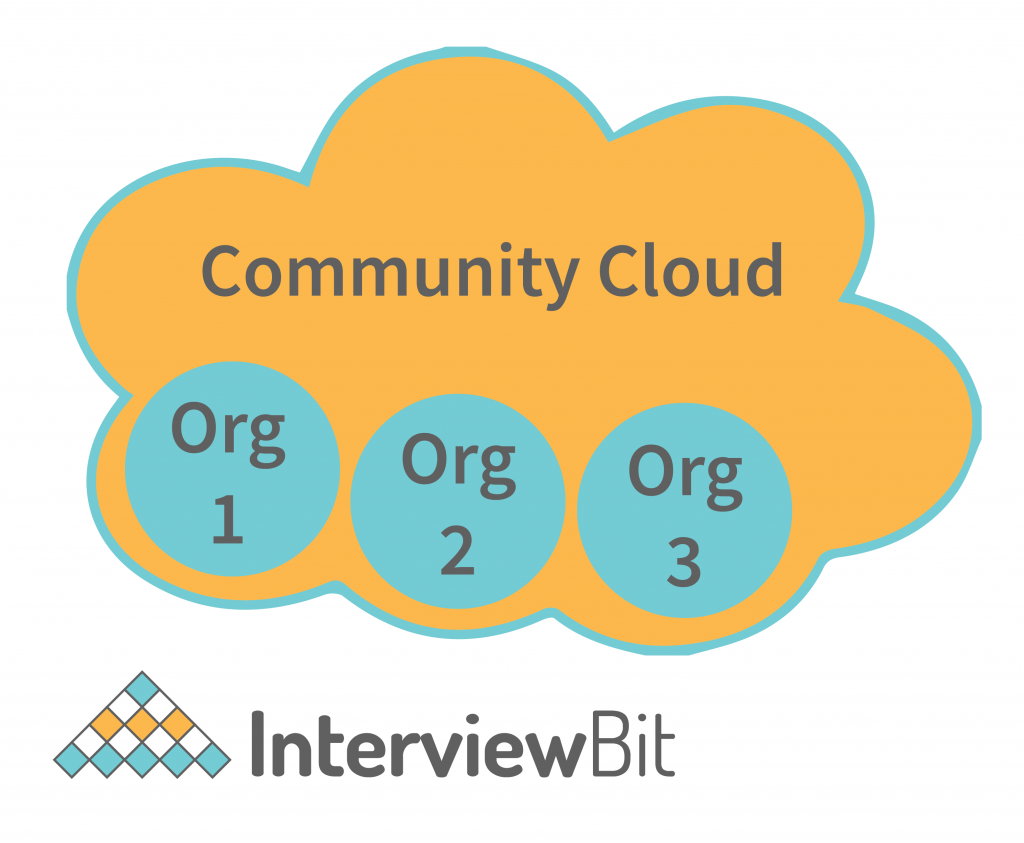
A community cloud is a cloud infrastructure that allows a group of companies to share information by accessing systems and services. One or more community organizations, a third party, or a combination of them own, administer, and run it.
Community clouds are used in the following industries:
- Media industry: Media organizations are seeking simple, low-cost strategies to improve content development efficiency. The majority of media works entail a large number of collaborators.
- Healthcare industry: Community clouds are used in the healthcare business to share information and knowledge on a worldwide scale while keeping sensitive data in private infrastructure.
Energy and core industry: In these industries, the community cloud is utilized to group a set of solutions that jointly address service and operations management, deployment, and orchestration. - Scientific research: Members of this group who share a common interest in science share a vast distributed scientific computing infrastructure.
Advantages of Community Cloud
- Low Cost: Because the entire cloud is shared by numerous enterprises or a community, a community cloud is cost-effective.
- Scalable and Adaptable: Because it is compatible with all users, the community cloud is both adaptable and scalable. It allows users to customize documents to their specific needs and requirements.
- Security: Community clouds are more secure than public or hybrid clouds.
- Sharing infrastructure: The community cloud enables several businesses to share cloud resources, infrastructure, and other features.
Disadvantages of Community Cloud
- Responsibility Distribution: For every company, community cloud is not the best option, as it can be challenging for organizations to share responsibility among themselves.
- Fixed Storage and Bandwidth: All community members are bound to a fixed amount of data storage and bandwidth sharing.
- Higher Cost: The cost of using the community cloud is higher than that of using the public cloud.
Low Security: When compared to private clouds, community clouds are not that safe and secure.
Now, that we have seen various types of cloud computing, namely, public clouds, private clouds, hybrid clouds, and community clouds, there are various questions, which can arise in your mind:
FAQs
Q.1: Which cloud type should be used where?
Ans: Public clouds will better suit high-volume or fluctuating-demand workloads Workloads with regular usage patterns may benefit from a private cloud environment. Because any task may be hosted anywhere, hybrid clouds are the catch-all.
Q.2: Which is the safest and most secure cloud type?
- Due to multi-tenancy and many access points, public clouds are more vulnerable to a larger range of security risks. Security responsibilities in public clouds are frequently shared. For example, infrastructure security may be the role of the provider, while workload security may be the responsibility of the tenant.
- Because workloads are normally run behind the user’s firewall, private clouds are regarded to be safe, however, this depends entirely on your own security.
- Users and administrators can limit data exposure by transferring workloads and data between environments based on compliance, audit, policy, or security requirements in hybrid cloud security, which combines the best aspects of each environment.
Q.3: Which is the most cost-effective cloud?
Ans: When scaling up a private cloud, the person who sets it up is normally responsible for purchasing or renting new hardware and resources.
In a public cloud, you typically pay for what you use, while some public clouds don’t charge tenants. Hence, public clouds are more cost-effective when compared to private clouds.
Q.4: Which cloud offers the best resources?
- Although public cloud users appear to have unrestricted access to resources, doing so frequently has more operational costs.
- Adding more private cloud resources necessitates the purchase or rental of additional hardware, all of which are capital expenses.
- Hybrid clouds allow you to scale out using operating expenses or scale up using capital expenses.
We tried to cover the types of cloud computing in detail here. You can learn about the most important cloud computing concepts that are being asked in technical interviews of various product-based companies from this article.







 Join WhatsApp Group
Join WhatsApp Group
